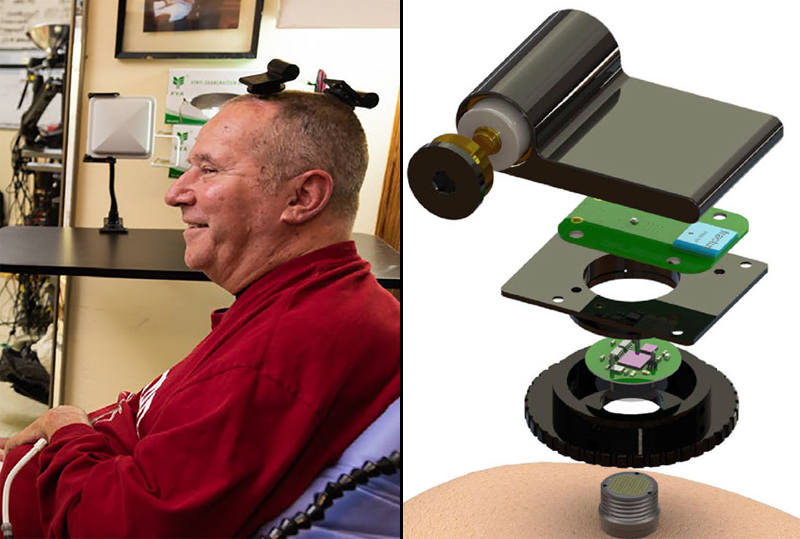
2nd April 2021 First high-bandwidth wireless brain-computer interface for humans Researchers at Brown University have created a brain-computer interface (BCI) with 200 electrodes providing 48 megabits per second (Mbit/s) of neural signals.
Brain-computer interfaces (BCIs) are an emerging assistive technology, enabling people with paralysis to type on computer screens or manipulate robotic prostheses just by thinking about moving their own bodies. For years, investigational BCIs used in clinical trials have required cables to connect the sensing array in the brain to computers that decode the signals and use them to drive external devices. Now, for the first time, clinical trial participants with quadriplegia have demonstrated the use of a wireless, high bandwidth, intracortical BCI with an external wireless transmitter. The new system is capable of transmitting brain signals at single-neuron resolution and in full broadband fidelity without physically tethering a user to a decoding system. Traditional cables are replaced by a small transmitter about 5 cm (2") in its largest dimension and weighing a little over 42 grams (1.5 oz). The unit sits on top of a user's head and connects to an electrode array within the brain's motor cortex, using the same port used by wired systems. For a study published in IEEE Transactions on Biomedical Engineering, two clinical trial participants with paralysis used the system – known as BrainGate – with a wireless transmitter to point, click and type on a standard tablet computer. The study showed that the wireless system transmitted signals with virtually the same fidelity as wired systems, and participants achieved similar point-and-click accuracy and typing speeds. "We've demonstrated that this wireless system is functionally equivalent to the wired systems that have been the gold standard in BCI performance for years," said John Simeral, Assistant Professor of Engineering at Brown University and the study's lead author. "The signals are recorded and transmitted with appropriately similar fidelity, which means we can use the same decoding algorithms we used with wired equipment. The only difference is that people no longer need to be physically tethered to our equipment, which opens up new possibilities in terms of how the system can be used." Although wireless devices with lower bandwidth have been reported previously, this is the first device to transmit the full spectrum of signals recorded by an intracortical sensor. The high-broadband wireless signal will enable neuroscience research that is much more difficult to perform with wired BCIs. The trial participants – a 35-year-old man and a 63-year-old man, both paralysed by spinal cord injuries – were able to use the BrainGate system in their homes, as opposed to a lab setting where most BCI research takes place. Unencumbered by cables, they used the BCI continuously for up to 24 hours, giving the researchers long-duration data, including while the participants slept.
"We want to understand how neural signals evolve over time," said Leigh Hochberg, Professor of Engineering at Brown, a researcher at Brown's Carney Institute for Brain Science and leader of the BrainGate clinical trial. "With this system, we're able to look at brain activity, at home, over long periods in a way that was nearly impossible before. This will help us to design decoding algorithms that provide for the seamless, intuitive, reliable restoration of communication and mobility for people with paralysis." The device used in this study had previously been demonstrated in monkeys, as they slept and woke or exercised. In the current study, two devices used together recorded neural signals at 48 Mbit/s from 200 electrodes, with a battery life of more than 36 hours. "I am privileged to be part of a team pushing the frontiers of brain-machine interfaces for human use," said Arto Nurmikko, Professor of Engineering and Physics at Brown, who developed the earlier version. "Importantly, the wireless technology described in our paper has helped us to gain crucial insight for the road ahead in pursuit of next-generation neurotechnologies – such as fully implanted, high-density, wireless electronic interfaces for the brain." "The evolution of intracortical BCIs from requiring a wire cable to instead using a miniature wireless transmitter is a major step toward functional use of fully implanted, high-performance neural interfaces," said study co-author Sharlene Flesher. "This study may be one of few that captures the full breadth of cortical signals for extended periods of time, including during practical BCI use." Brown University has signed a licensing agreement with neural engineering and neuroprosthetics company Blackrock Microsystems, to make the device available for researchers around the world. The BrainGate team plans to continue testing the device in ongoing clinical trials.
Comments »
If you enjoyed this article, please consider sharing it:
|








